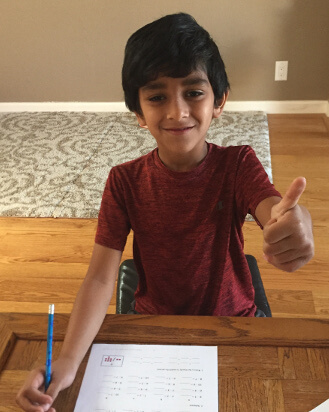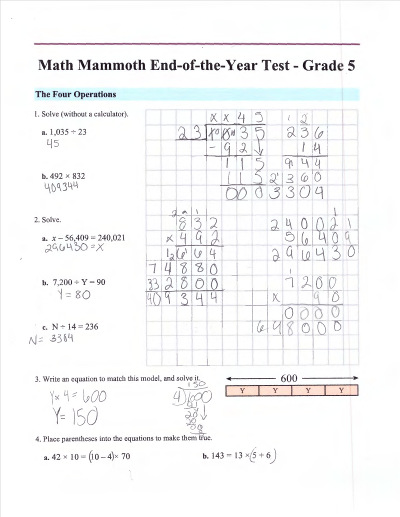Math Mammoth placement tests for grades 1-8 (free math assessment)

These free diagnostic tests help you discover your child or student's level in math, and to find out EXACTLY where they have gaps (if any). They are end-of-year (EOY) tests — in other words, meant to be taken AFTER studying the particular grade.
While the tests ARE placement tests for Math Mammoth complete curriculum, they work equally well as GENERIC math assessment tests.
Using the tests will allow you to tailor the instruction to help the child/student right where they need help the most. You can EASILY find out if your student has not learned specific topics, because the tests group the questions by topic. Just look at the test results per "sections" of similar problems (addition, multiplication, measuring, geometry, place value, problem solving).
You can always send me your child's test results if in doubt. (Just send me the point counts for each test item.)
Back to the math placement tests... to start, look over the tests and try to find the highest level one that you THINK your student or child will pass. Then you would naturally administer that test.
The video below explains the basics of HOW to use these tests:
This table shows the possible score ranges and how to interpret the result:
| Score | Meaning |
|---|---|
| 90% or more | Administer the next higher level test. |
| 80% to 89% | The student can go on to the next grade level in Math Mammoth. |
| 70% to 79% | The student can probably go on to the next grade level in Math Mammoth, but may need help in filling in gaps. Use your judgment. |
| 50% to 69% | The student can possibly be placed to the grade level of the test. Or, you might administer the next lower level test in order to get a fuller picture of what the student knows and doesn't know. |
| less than 50% | Administer the next lower level test. |
However, it's quite possible that just that one test will not give you a good overview of what the student has mastered. So don't be afraid of administering two or even three tests — or parts of tests. For example, let's say a student gets 70% on a test, and in particular, they get a low score in the geometry section of the test. In that case, it is beneficial to administer the GEOMETRY sections of the next lower level tests also, in order to find out how "large" a gap they have in geometry.

Sometimes, a student who is seriously behind can get a low score on even THREE subsequent tests. Basically, their skills and knowledge are "all over the place" so to speak. Such students can benefit from a tailored approach where the materials they will study will be exactly matched to the gaps they have.
One more important thing. To reduce the test-taking stress, don't put any strict time limit for the completion of the test. We don't want students to build any anxiety over this placement test or tests. Now, some children have already developed anxiety towards test-taking and/or towards math in general. In such cases, it might be best to avoid even these tests, or at least postpone the test-taking until the anxiety has subsided somewhat.
Downloads
- End-of-Year Test, Kindergarten
At this time we don't have an answer key available for this test. It should be very easy for an adult to check, though! - End-of-Year Test, Grade 1
Answer Key - End-of-Year Test, Grade 2
Answer Key - End-of-Year Test, Grade 3 (2024 edition)
Answer Key (2024 edition) - End-of-Year Test, Grade 3 (2018 edition)
Answer Key (2018 edition) - End-of-Year Test, Grade 4
Answer Key - End-of-Year Test, Grade 5
Answer Key - End-of-Year Test, Grade 6
Answer Key -
End-of-Year Test, Grade 7 (pre-algebra)
Answer Key -
End-of-Year Test, Grade 8
Answer Key
Canadian versions
These are all-metric and formatted to Letter size paper. For grades 1-2, the tests use Canadian coins and bills.
- End-of-Year Test, Grade 1 (Canadian version)
Answer key - End-of-Year Test, Grade 2 (Canadian version)
Answer key - End-of-Year Test, Grade 3 (Canadian version)
Answer key - End-of-Year Test, Grade 4 (Canadian version)
Answer key - End-of-Year Test, Grade 5 (Canadian version)
Answer key - End-of-Year Test, Grade 6 (Canadian version)
Answer key - End-of-Year Test, Grade 7 (Canadian version)
Answer key - End-of-Year Test, Grade 8 (Canadian version)
Answer key
International versions (all metric)
The international versions are formatted to A4 paper size, use a space for thousands separator (35 230), and only use metric units. The tests for grades 1 and 2 include a section on counting coins, which is with Australian currency. The rest of the tests don't have questions about coins or bills, and use the "$" symbol for currency.
- End-of-Year Test, Grade 1 (International version)
Answer key - End-of-Year Test, Grade 2 (International version)
Answer key - End-of-Year Test, Grade 3 (International version)
Answer key - End-of-Year Test, Grade 4 (International version)
Answer key - End-of-Year Test, Grade 5 (International version)
Answer key - End-of-Year Test, Grade 6 (International version)
Answer key - End-of-Year Test, Grade 7 (International version)
Answer key - End-of-Year Test, Grade 8 (International version)
Answer key
International-UK versions with pounds & pence (all metric)
The versions below are formatted to A4 paper size and only use metric units. They use British coins and bills.
- End-of-Year Test, Grade 1 (British version)
Answer key - End-of-Year Test, Grade 2 (British version)
Answer key - End-of-Year Test, Grade 3 (British version)
Answer key
International-euro versions with euro coins and bills & decimal comma
The versions below are formatted to A4 paper size, use a space for thousands separator (35 230), and only use metric units. They use euro coins and bills, and a decimal comma for money amounts.
- End-of-Year Test, Grade 1 (euro)
Answer key - End-of-Year Test, Grade 2 (euro)
Answer key - End-of-Year Test, Grade 3 (euro)
Answer key
Tip: If you notice your child has problems with one or two concept areas in a particular test, but otherwise does fine, you can use Math Mammoth Blue Series books to "fill in those gaps". You can also email me with your test results if you have trouble deciding which Blue Series book you should use for such remedial work.
Math Mammoth grade-level review workbooks can also be used to pinpoint areas of weakness or to review a whole grade level of topics.
An example
 Here is an example of one student's test results and the placement advice I gave to the parent of this student.
Here is an example of one student's test results and the placement advice I gave to the parent of this student.
Background: the student began homeschooling the same year as the tests were taken and is technically in 7th grade. She had started doing Teaching Textbooks Algebra 1. However, the parent noticed that she didn't know some basic fraction information, decided to look for a supplement, and came across Math Mammoth.
The student took three end-of-year tests: for grade 6, grade 5, and grade 4. You can see her work for grade 5 and grade 6 tests in the links below. (She did not do very well in the grade 6 test.) If you decide to send me your child's test results, it is not necessary to send me the complete test like this person did, but it makes a good example. Most people send me only the point counts for the various test items.
- Grade 5 test, complete work of the student
- Grade 5 test, the student's score
- Grade 6 test, complete work of the student
- Grade 6 test, the student's score
And here is my assessment and recommendations:
I think it's a good idea to have her start at grade 5 in Math Mammoth.
Additionally, I feel she should study these books from the Blue series.
- Early Geometry, because she doesn't seem to understand the concepts of area and perimeter – which are of paramount importance. This book is for grades 1-3 so some topics in it are too easy and she can skip them.
- Geometry 1 – meant for grades 4-5. She will need to study the lessons that are in 4th grade level first (angles, quadrilaterals, triangles, etc.) Please note some of the content here overlaps with MM grade 5. She can study the overlapping lessons from either source.
- Measuring 1 – it is for grades 1-3 but she may need to review everything from the beginning when it comes to measuring units. Some lessons may be too easy and can be omitted - use your judgment on that.
- Measuring 2 – for grades 4-6. Please note some of the content here overlaps with MM grades 5 and 6. She can study the overlapping lessons from either source.
- Decimals 1
She has not grasped the basics of how fractions and decimals tie together – which, once again, is a very fundamental concept. She should study Decimals 1 book before starting the decimals chapter in grade 5.
Other than those few areas (geometry, measuring, decimals), she can be placed into MM 5.
By the way, don't assign all the problems that have to do with calculations (large exercise sets) in any of the materials. It's enough to assign maybe 1/3 of those at first. If she has difficulties, then use the rest (and that may be the case when it comes to, say, perimeter and area).
And, she did really well with the first two sections of grade 5 end-of-year-test, which means she could perhaps skip the first two chapters in MM5. You could let her study the chapter reviews and/or tests from those 2 chapters. Check and see how she does with them, and then use your judgment if she'd need to study any of the lessons from those chapters.
Thankfully, she also understands many things of fraction arithmetic, which will make things go quicker in part 5-B.
I'm really glad her 'gaps' are not in general problem solving! It's far easier to deal with topics such as measuring units, area, and perimeter, than to fix a general lack of not being able to solve word problems (which is the case with many children).
Sincerely,
Maria Miller
Questions about placement
- My K student wants more challenge and to do 1st grade math. How can I know if the Light Blue grade 1 is the right choice for my child?
The Light Blue grade 1 starts out with the same material as these books from the Blue Series: Addition 1 and Subtraction 1. Look over those, see their samples and contents, and that will probably tell you if your children are ready for grade 1. - I thought my child had been doing fine in math previously (getting A's and B's), but he/she still failed the placement test for their particular grade level.
This is common for a child coming from public school or from another math curriculum. It is typically due to the facts that (i) Math Mammoth uses multi-step word problems extensively from 2nd grade onward; and (ii) the child may not have covered all the topics in the other curriculum as what are covered in MM. Geometry & measuring often end up being such areas.
To catch up, please see the Tip above about using the Blue Series books. Another thing you can do is accelerate through the earlier levels of Math Mammoth, for example by studying the chapter reviews, and stopping to study any concept that the child has not understood.
This kind of process can typically be done in only a few months, so don't worry! It is much more important to get a solid foundation in math than to look at the grade levels and just go on. In math, it is crucial to understand the previous concepts, because if not, the student WILL eventually fail and most also start hating math.
See also this thread on a homeschool discussion forum: Unexpected experience with end-of-year test for Math Mammoth. - A student misses (or doesn't even try) most of the word problems in the test but does okay with calculation problems.
This is a common situation for many students. It usually stems from the lack of good word problems in the math program the student has used previously. Please read what I have written about the problem with word problems so you can understand the origins of this difficulty better.
Our books Foundational Word Problems (grades 3+) and Discovery Word Problems (grades 4+) are designed to help such students.
Additionally or alternatively, your student could go through certain books in the Blue Series, doing only the word problems and the lessons pertaining to word problems. Use this as a guideline:Student attempted the 2nd grade EOY test:
Add & Subtract 2-A, Add & Subtract 2-B, and half of Add & Subtract 3.Student attempted the 3rd grade EOY test:
(possibly Add & Subtract 2-A) Add & Subtract 2-B, Add & Subtract 3, Multiplication 1, and Division 1.Student attempted the 4th grade EOY test:
Add & Subtract 3, Multiplication 1, Division 1, Multiplication 2, and Division 2. - My child did OK on the test except such-and-such area or topic. Can you help me choose remedial materials?
Please see the following chart.
Area of lack Remedial book Addition and subtraction facts within 0-10 Subtraction 1 Addition and subtraction facts within 0-18 Add & Subtract 2-A Place value of tens and ones Place Value 1 Place value of 3-digit numbers Place Value 2 Place value of 4-digit numbers Place Value 3 Mental math - addition and subtraction strategies for 2-digit numbers Add & Subtract 2-B Mental math - addition and subtraction strategies for 3-digit numbers Add & Subtract 3 Multiplication concept, multiplication tables, or simple multiplication word problems (grade 3) Multiplication 1 Multi-digit multiplication and related word problems (grades 4-5) Multiplication 2 Basic word problems Foundational Word Problems Prime factorization, LCM, GCF (grades 4-6) Multiplication & Division 3 Basic division concept (single-digit divisors) and related word problems (grade 3) Division 1 Long division and related word problems (grades 4-5) Division 2 Reading the clock, telling time, or elapsed time Clock Any measuring-related difficulty within grades 1-3, including not knowing metric units Measuring 1 Geometric concepts within grades 1-3 Early Geometry Geometry (grades 4-7) Geometry 1 and Geometry 2 Fraction concepts within grades 2-4 Introduction to Fractions Fraction topics within grades 5-6 Fractions 1 and Fractions 2 Basic concept of decimals (grades 3-4) Decimals 1 Decimal arithmetic (grades 5-6) Decimals 2 Ratios and proportions (grades 6-7) Ratios, Proportions & Problem Solving Percent (grades 6-7) Percent Integers (grades 6-7) Integers Statistics (grades 5-7) Statistics & Probability
- I'm a Math-U-See user and my child has not studied some of the materials you cover earlier than MUS. How do I switch over to Math Mammoth?
I'd simply recommend you first have her take a placement test to know exactly what she knows and what she doesn't about those topics that MUS does not cover as much, such as measuring, money, clock, geometry and problem solving.
Then once you have had the child take the test, you can choose books from the Blue Series to address specific topic areas (see the chart above).
Remember also, I'm ready to guide you with these decisions. Just let me know the child's test results by sections.
By Maria Miller
Receive my monthly collection of math tips & resources directly in your inbox — and get a FREE Math Mammoth book!
You can unsubscribe at any time.
Math Mammoth TourConfused about the different options? Take a virtual email tour around Math Mammoth! You'll receive: An initial email to download your GIFT of over 400 free worksheets and sample pages from my books. Six other "TOURSTOP" emails that explain the important things and commonly asked questions concerning Math Mammoth curriculum. (Find out the differences between all these different-colored series!)This way, you'll have time to digest the information over one or two weeks, plus an opportunity to ask me personally about the curriculum. A monthly collection of math teaching tips & Math Mammoth updates (unsubscribe any time) We respect your email privacy.
Note: You will FIRST get an email that asks you to confirm your email address. If you cannot find this confirmation email, please check your SPAM/JUNK folder. |
"Mini" Math Teaching CourseThis is a little "virtual" 2-week course, where you will receive emails on important topics on teaching math, including:
- How to help a student who is behind You will also receive: A GIFT of over 400 free worksheets and sample pages from my books right in the very beginning.We respect your email privacy.
Note: You will FIRST get an email that asks you to confirm your email address. If you cannot find this confirmation email, please check your SPAM/JUNK folder. |
Maria's Math TipsEnter your email to receive math teaching tips, resources, Math Mammoth news & sales, humor, and more! I tend to send out these tips about once monthly, near the beginning of the month, but occasionally you may hear from me twice per month (and sometimes less often). Peek at the previous tips here. You will also receive:
We respect your email privacy.
|
|
